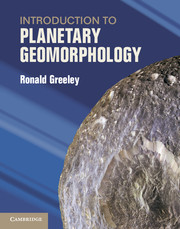Book contents
- Frontmatter
- Contents
- Foreword
- Preface
- Acknowledgments
- Chapter 1 Introduction
- Chapter 2 Planetary geomorphology methods
- Chapter 3 Planetary morphologic processes
- Chapter 4 Earth’s Moon
- Chapter 5 Mercury
- Chapter 6 Venus
- Chapter 7 Mars
- Chapter 8 The Jupiter system
- Chapter 9 The Saturn system
- Chapter 10 The Uranus and Neptune systems
- Chapter 11 Planetary geoscience future
- Appendices
- References
- Further Reading
- Index
Chapter 11 - Planetary geoscience future
Published online by Cambridge University Press: 05 February 2013
- Frontmatter
- Contents
- Foreword
- Preface
- Acknowledgments
- Chapter 1 Introduction
- Chapter 2 Planetary geomorphology methods
- Chapter 3 Planetary morphologic processes
- Chapter 4 Earth’s Moon
- Chapter 5 Mercury
- Chapter 6 Venus
- Chapter 7 Mars
- Chapter 8 The Jupiter system
- Chapter 9 The Saturn system
- Chapter 10 The Uranus and Neptune systems
- Chapter 11 Planetary geoscience future
- Appendices
- References
- Further Reading
- Index
Summary
Introduction
Planetary geosciences are advanced primarily through new data and are stimulated by physical and computational modeling, theoretical studies, and field studies of terrestrial analogs in support of planetary data analysis. As shown in Fig. 1.11, missions are currently in flight for Mercury, Venus, the Moon, Mars, Jupiter, Saturn, and Pluto, as well as for a host of asteroids and comets. Particularly noteworthy is the New Horizons mission, which will give us our first close-up views of Pluto in 2015. Spacecraft for these missions carry sophisticated scientific payloads, including imaging systems that will provide additional coverage, higher resolution, or first ever views of planetary objects of geoscience interest.
Most planetary missions are flown by NASA, some in partnership with the European Space Agency, which also flies planetary missions independently of NASA. In addition, the space agencies of Japan, India, and China are becoming increasingly important, especially in lunar exploration and the eventual return of humans to the Moon. (After a hiatus of many years, in 2012 Russia attempted to resume planetary exploration with a mission to one of the moons of Mars, Phobos, but that mission failed shortly after launch.) Although NASA had planned lunar exploration by humans early in the twenty-first century, such plans have been deferred because of the economic climate. In its place, considerations are being given to sending humans to one or more asteroids because of the lower costs (it is easier to return to Earth from these low-gravity bodies), the high scientific potential of asteroids, and the need to assess asteroids as hazards to Earth.
- Type
- Chapter
- Information
- Introduction to Planetary Geomorphology , pp. 210 - 215Publisher: Cambridge University PressPrint publication year: 2013



